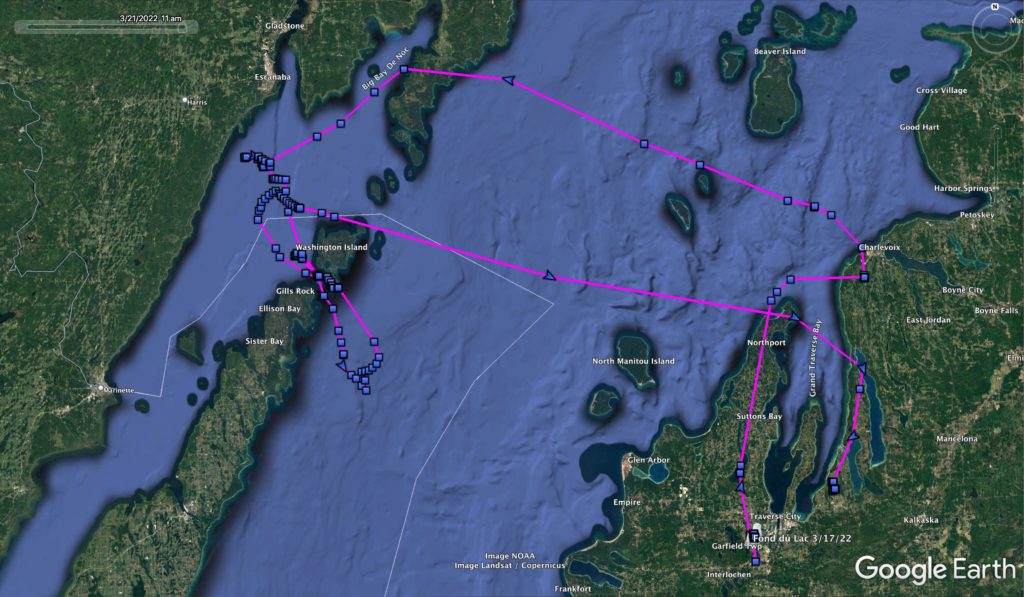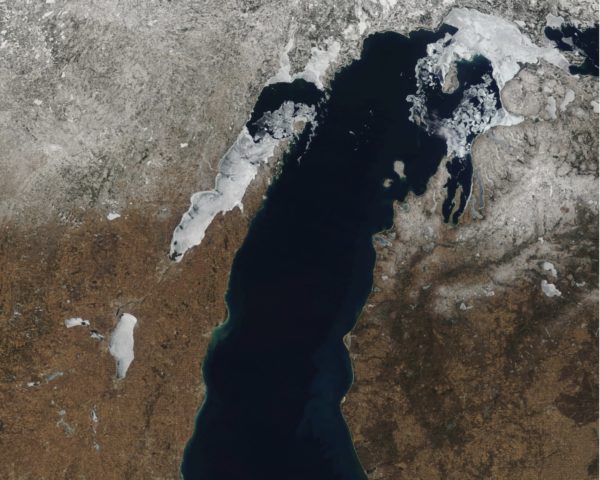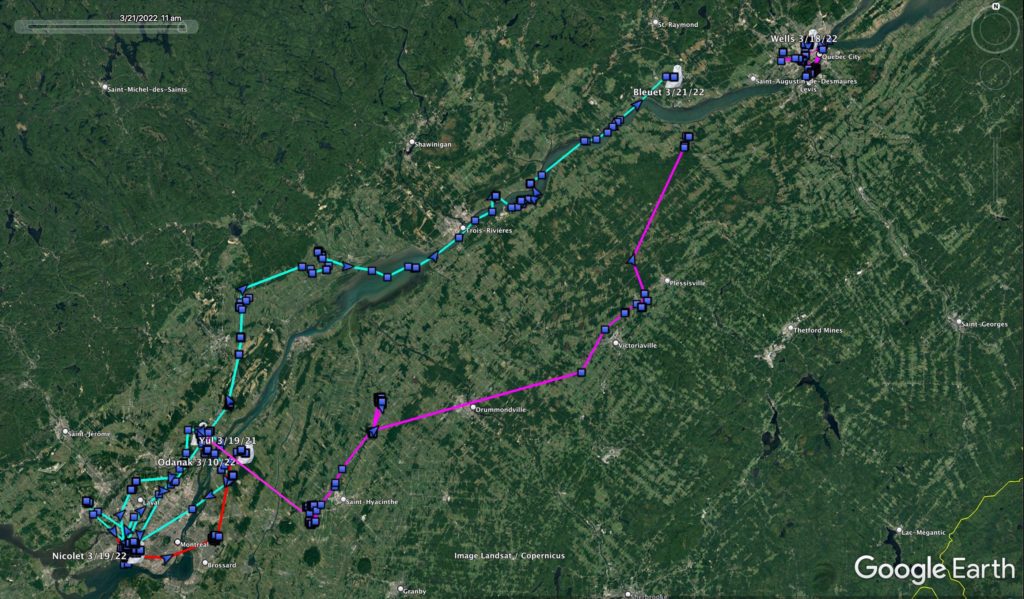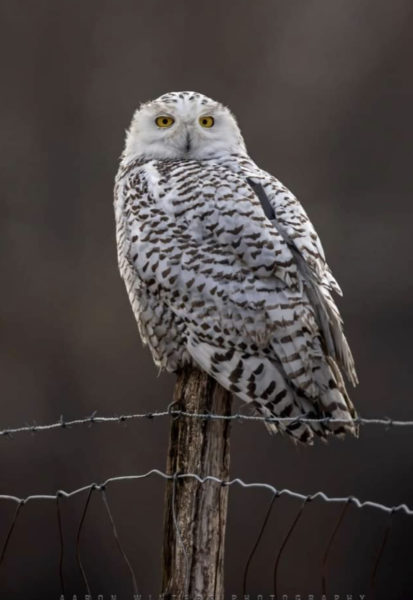
Fond du Lac took quite the little excursion across Lake Michigan, almost all of it over open water. (©Project SNOWstorm and Google Earth)
The past couple of weeks have seen some pulses of late-winter warmth into the Northeast, and along with longer days, it’s definitely having an effect on some of our owls. This is the time of year when we expect breeding-age adults especially to get antsy, and several of them have indeed begun moving in a noticeable way — though in one case, a young owl is moving in decidedly the “wrong” direction.
Let’s start with those snowies who are still holding steady on their winter-long territories. That’s the case for Wells in Québec City (though she’s spending more time along the riverfront); Echo on Lake Ontario; Hochelaga and Nicolet in Montréal; Otter up on Lake Abitibi in western Québec; Roc at the Rochester, NY, airport; Romulus in the thumb of Michigan; and Stella in southern Saskatchewan.

As this satellite image from March 20 makes plain, Fond du Lac’s two 65-mile (105 km) flights across Lake Michigan were over almost entirely open water. (NOAA CoastWatch imagery)
Since early March, Columbia has moved 80 miles (125 km) north from near Fargo to Grand Forks, ND, where since March 16 she’s been hanging out around the Grand Forks sewage disposal ponds. But Fond du Lac, who had been anchored at a golf course south of Traverse Bay, MI, for much of the winter, really hit the road March 11. Over the next six days he flew a total of 340 miles (545 km) in several big loops west across Lake Michigan to Green Bay and Big Bay de Noc on the Wisconsin/Michigan border, then east back to Grand Traverse Bay to exactly where he’d started, the Crown Golf Club. In doing so he crossed more than 65 miles (105 km) of open water twice, because Lake Michigan is largely ice-free this winter.

Bleuet (blue) has moved hundreds of kilometers northeast along the St. Lawrence, while Yul (purple) went almost to Québec City and returned, and Odanak (red) has been off the grid since March 10. (©Project SNOWstorm and Google Earth)
In Québec, three of our Montréal-area owls have been on the move. Odanak left the airport on March 7 and last checked in March 10 about 45 km (28 miles) northeast of the city; we’ve had nothing from her since, which may indicate she’d moved up into southern Québec where the cell service is much spottier. Yul has been moving a lot, but her transmitter voltage has been fluctuating and we have a lot of gaps in her data, but in late February she flew almost all the way from near Montréal to just short of Québec City, then returned to near Saint-Hyacinthe. On March 19 she had crossed the St. Lawrence and was just beyond the Montréal suburb of Repentigny.
Bleuet also made a bunch of short exploratory flights away from the Montréal airport in late February, then on March 16 began a determined migration northeast along the north shore of the St. Lawrence, covering 224 km (140 miles) in three nights. Today she was near Pont-Rouge, QC, about 30 km (18 miles) from Québec City.

Which way? Britton has decided it’s the perfect time to migrate south. (©Project SNOWstorm and Google Earth)

Britton, in Geneseo, NY, and headed for points south. (©Aaron Winters)
The one owl going the wrong way — at least for this time of year — is Britton, the immature female relocated last month from the Rochester, NY, airport. She quickly boomeranged back to Rochester, but in the past week she began moving, making short flights away from the airfield. Then on March 18 Britton began flying almost due south, and by midday today she had moved 85 miles (137 km) into northcentral Pennsylvania, near the town of Ulysses in Potter Co. (When she was near Geneseo, NY, our friend Aaron Winters got this great photo of her perched on a fencepost.)
She’s just on the northern edge of the densely forested Allegheny Plateau, which is hardly good habitat for a snowy owl, and may convince her to turn north again — but maybe not. Why go south at a time when a lot of birds are migrating north? You’d have to ask Britton, but we often see a kind of pre-migratory restlessness (ornithologists use the German term zugunruhe) in snowy owls at this time of year. This will be Britton’s first northbound migration, and her body may just be telling her it’s time to move, without yet giving her the hormonal direction to specifically go north. Also, snowies don’t mature sexually until they’re at least a few years old, so she doesn’t have a biological clock ticking down the days until breeding season in the Arctic, like the adults do.


10 Comments on “On the Move (Direction, um…Uncertain)”
I believe Britton is located in Bradford, Pa. She has been in the same area for a few months. I see her every single day.
That’s a different owl, Katie — thanks to her transmitter we know exactly where Britton has been for the past month, mostly at the Rochester, NY, airport, until she made her abrupt flight south into Pennsylvania over the weekend. Nice to know she’s not the only snowy in northern PA.
Scott,
You may already have looked at this, and it may or may not be relevant, but related to Fond du Lac’s movement across northern Lake Michigan. Looking at eBird reports and consistent with many previous years, there are a lot of waterfowl piled up in Green Bay and Grand Traverse Bay, so perhaps the travels were a shopping trip?
That’s enlightening, Allen — thanks for the tip! And it makes a lot of sense, because in years past we’ve seen snowy owls haunting the ice edge on lakes like Ontario and Erie at this time of year, hunting for migrant waterfowl. I imagine Fond du Lac was enjoying the buffet. One concern for any snowy feeding on waterfowl right now is the widespread presence of highly pathogenic avian influenza (HPAI) in waterfowl, which is causing enormous concern in the poultry industry but also is having an impact on wild raptors. Waterfowl seem to handle HPAI pretty well, but raptors including snowy owls are highly susceptible to it. I’ll be posting more soon about HPAI and how it’s affecting our work and the risk to snowy owls more generally.
Katie Johnson, is the owl still around, if so I would like to possible photograph her ..
I live in Warren County Pa.
Bill SIMBECK
simbeck photo@gmail.com
I am very interested in hearing your thoughts on HPAI and raptors. I volunteer at On The Wing in Epping, NH and have heard of at least one deceased snowy owl confirmed with the virus.
For the past two days we’ve sighted a big male snowy owl. Late afternoon/early evening sitting on the ground in the fields. We thought they had already left , so we were pretty excited to see him! We are located a mile west of McBain, Mi.
Hi
I was wondering if you had one more satellite transmitter to put on a very special snowy owl up here on the New Hampshire coast? He’s been named Seabrook for the town he chose to hang out in this winter. back in February he was found sick on the beach and was rehabbed from ingesting the rat poison and released. he was released 10 miles away but came back to the area he had originally taken up residence in. Unfortunately the first week of may he was again sickened by this rat poison and it’s currently back at the rehabbers. though he is doing very well as of today and has been moved to an outdoor enclosure.
First off, Steven, I’m sorry for the slow reply, and I’m sorry to hear about this owl’s problems — an example of the real menace rodenticides pose to raptors. In the past we’ve tended to avoid tagging rehabbed birds because we figured they’ve already gone through enough and didn’t need an additional burden on release. Given what it sounds like this owl has gone through already, we’d be reluctant to add anything further that might hinder its recovery…the transmitters are only a few percent of the owl’s body weight, but it is an extra challenge. That said, there is increasing interest among rehabbers to use tracking technology to assess the survival rate of rehabbed raptors, and we’re talking with our veterinary team about how we can start addressing that knowledge gap beginning next winter. I suspect we’d want to use smaller, lighter transmitters, perhaps with minimal functions, to minimize weight and thus make it as easy for the owl as possible. We’ll have more to say about this project next season. Meanwhile, I hope “Seabrook” makes a full and permanent recovery.
I’m late just seeing this reply.
Thank youso much for considering and helping Seabrook as you did.